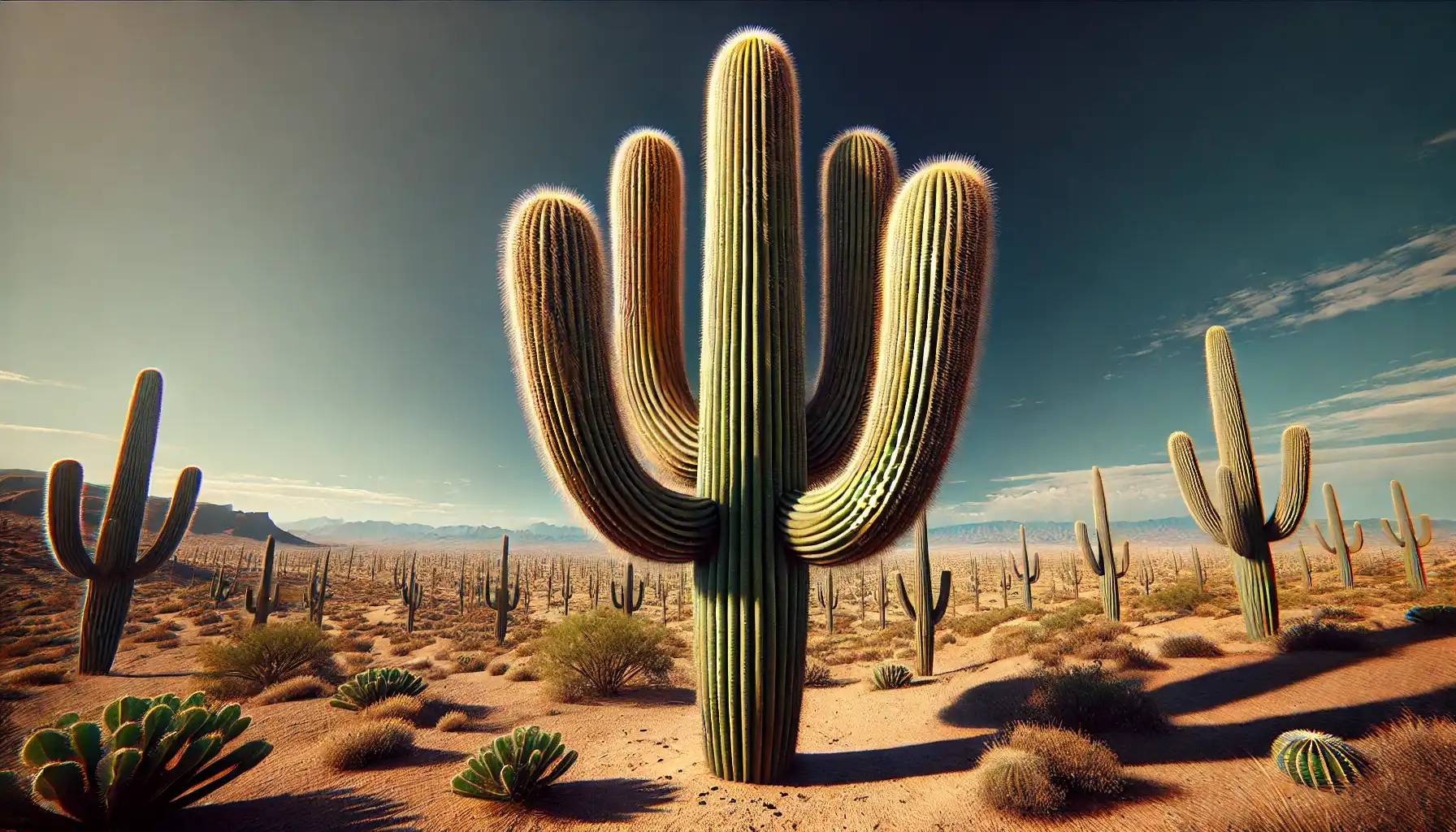What can be a more illustrative symbol of the American desert than a Saguaro cactus, a towering giant with a long lifespan and unmistakable silhouette? The Saguaro cactus is an iconic instance of the western flora that managed to take root in the world’s culture for good. But what are the main peculiarities of Saguaro?
Today, we are going to explore the nature of the Saguaro cactus, go through its adaptation mechanisms, and learn more about its habitat, i.e., the American desert with severe conditions to overcome. So, what do you hide, Saguaro?
A Giant Among Giants
The Saguaro cactus, scientifically known as Carnegiea gigantea is an enormous stem succulent that can grow up to 40 feet (12 meters) tall and live for over 150 years on average. It is no wonder that the Saguaros are considered one of the largest and longest-living cactus species in the world.
The towering constitution of the Saguaro cacti is the most distinctive feature of a plant. With arms, which can number in the dozens, these floral instances grow grand and play a crucial role in the desert ecosystem, for they can create a safe space for wildlife, e.g., birds, bats, insects, and the like.
Saguaro’s Survival Mechanisms
Since the environment usually defines how its plants are to assimilate and look in the end, the Saguaro cactus also has evolved several remarkable mechanisms so as to survive and even thrive in areas of harsh conditions and limited resources. First of all, like the majority of other cacti, Saguaros are able to store large volumes of water in their stems covered with thick glossy skin, thus minimizing moisture loss, too.
As for the roots, due to the lack of hydration and infrequent rains, Saguaros have extensive yet shallow root systems that optimize water absorption. So as to keep as much moisture as possible, cacti have developed spines that somehow shade the plant body, as well as provide protection from herbivores.
Saguaro Growth: Process and Structure
The growth of a Saguaro cactus is slow yet remarkable. At its very start, the cactus emerges as a tiny seed that germinates under the protection of its nurse tree, a mature plant that provides shade and offers an opportunity for a little creature to develop. This might take several years thanks to the slow but efficient growth rate of one inch per year.
In general, cacti need more and more arms to increase the number of flowers and fruits, and by the age of 150-200, they may have dozens of arms all around the body. As soon as the plant is mature enough to reproduce, there appear flowers to turn into sweet fruits that contain tiny black seeds surrounded by red juicy flesh. Those deliciously-looking structures have always attracted birds, bats, and humans alike, facilitating the spread of Saguaro cacti.
Where Do Saguaro Cacti Grow?
Although the picture of a Saguaro cactus is widely recognized, the only place where they can grow is the Sonoran Desert, located in the southwestern United States (i.e., southern Arizona) and northwestern Mexico (i.e., Sonora). The plant cannot grow up to 4,500 to 5,000 feet (approximately 1,370 to 1,500 meters) in elevation. And the ideal conditions for Saguaros found there presuppose hot temperatures, bimodal rainfall patterns, and sandy, well-drained soil, too.
Cacti Identification with AI Plant Finder
Exploring new plants is always a memorable experience; and when it refers to cacti, these alien creations here on Earth, plant identification turns into a game. How can we learn more about cacti around us as we encounter them for the first time? Plant ID apps represent a perfect solution for a smooth and precise process with little to no mistakes to notice.
Such platforms as AI Plant Finder offer a unique experience that focuses on on-site assistance for plant lovers of all sorts. So as to identify floral representatives, access the application, tap on the Camera button, and point your smartphone at the plant for the system to process the data and lead you to the plant card. There, one is free to explore details about its habitat, plant care requirements, growth needs, toxicity level, and interesting facts, too!
By the way, the app has built-in features that can help you manage your gardening routine with ease. Try a water calculator, illuminance meter, plant care reminders, and an AI Botanist today and stay on top of your plant's needs.
Fun FAQs
How do you tell the age of a cactus?
Unlike trees, cacti do not have annual growth rings that could tell the exact age of the plant. However, taking into consideration the growth rate and the number of arms, we can roughly estimate how old a cactus is. So, how do you tell the age of a Saguaro cactus? Make a calculation, but remember Saguaros typically grow 1 to 1.5 inches (2.5 to 3.8 cm) per year and arms appear around 50 to 75 years of age.
Is the Saguaro the largest cactus in the world?
Yes, Saguaros are considered one of the largest cacti in the world, and the most gigantic instance has reached a height of 78 feet. Nevertheless, nature does not stop and produce other types of cacti that can grow taller and more massive when compared to the Saguaro variety.
How did people use Saguaro Cacti in the past?
Back in time, the Tohono O’odham people native to the Sonoran region made use of the sweet cactus fruits and produced syrups, jams, wine, etc., while seeds were to be ground into flour. Additionally, the woody ribs of the inner part of the cactus were employed when building shelters and making instruments, too. All in all, the application of the Saguaro cacti has never been limited but it infiltrated other spheres at last.






